Water garden ideas – 9 ways to introduce soothing water to your outdoor space
From cascading fountains to wildlife ponds, there are plenty of ways to create a tranquil water garden


Rachel Crow
From small-scale decorative features, through wildlife ponds, to natural swimming pools, the possibilities for creating a water garden in your outdoor space are diverse.
You may like a grand fountain as a focal point in a formal garden; an added sensory dimension to enjoy while dining alfresco; a hidden away oasis of calm, or a stream meandering through a rockery – there are so many options to choose from.
Attracting wildlife to the garden is bound to be a consideration and will guide not only the location of your water garden but also the ease of access for your little visitors. As with any water feature ideas, the first decision to make is where to position them. This may then dictate the options open to you in terms of what will work with the rest of your backyard space.

A gardening writer and photographer, Leigh Clapp has over 25 years' experience of photographing beautiful gardens and writing on all manner of things horticultural. Leigh’s work appears in magazines, newspapers and books, both in the UK and abroad, including Period Living, Country Life, and Gardens Illustrated. She is also the author of Vertical Gardens, available on Amazon.
Soothing water garden ideas to add to your plot
When deciding on which water garden ideas you want to include in your backyard, consider what effect you wish to create. Would you prefer a still garden pond presenting a picture akin to Monet’s Water Lilies; do you enjoy the sound of trickling water as a sensory garden idea; a babbling brook, or water cascading down levels?
In terms of the style of the water garden, will it need to fit in with a cottage garden style, a traditional aesthetic, or a more formal garden design?
Your budget, is, of course, an important consideration, with the cost of installing a water garden varying greatly depending on the design and style chosen. Also, safety is paramount for small children in a family backyard, so any design should not present a potential hazard.
1. Surround a water garden with boardwalk and decking
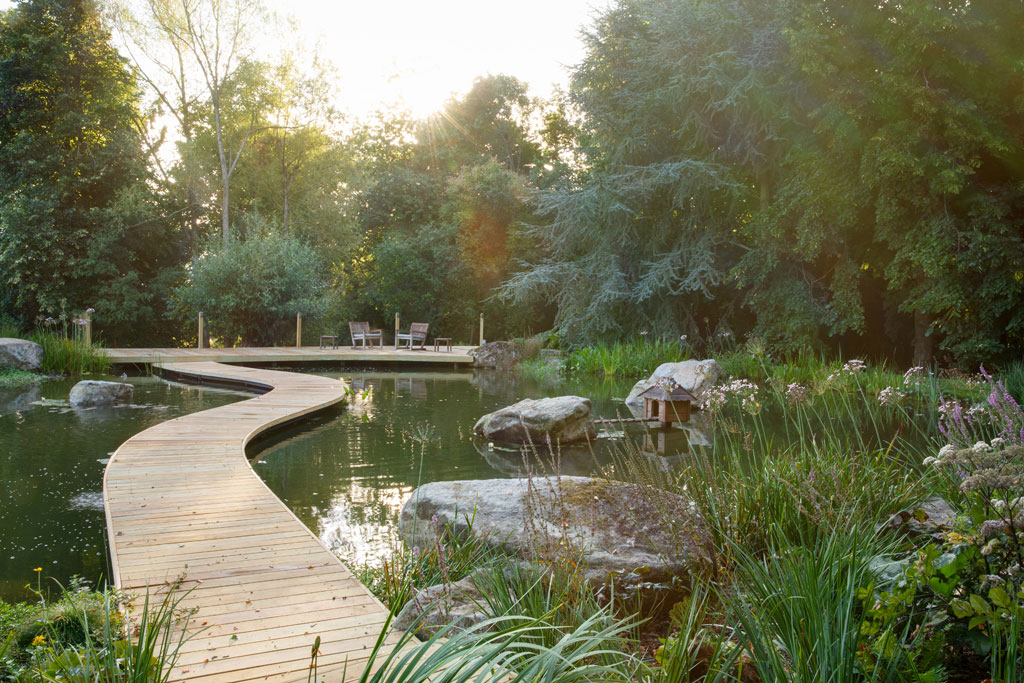
A timber boardwalk can allow you to enjoy a water garden from all angles
If you have the space in your backyard, incorporate a stunning water garden that features many elements, including surrounding decking and a walkway, so you can fully immerse yourself in the space.
Design expertise in your inbox – from inspiring decorating ideas and beautiful celebrity homes to practical gardening advice and shopping round-ups.
This stunning expanse of water, complete with glacial boulders and a wooden walkway snaking through it, was designed by award-winning garden designer Jo Alderson and built by The Garden Design Company.
'If a water garden is located further away from the house in the wider landscape, it’s crucial that the feature nestles into the landscape. The feature should incorporate marginal sloping shelves so that different aquatic and marginal plants can be incorporated,' explains Rob Jones, director at The Garden Design Company.
'Overflows in case of heavy rain should be added, but this provides opportunities for a neighboring bog garden to be created, filled with the likes of gunneras, hostas, and ferns,' Rob adds.
Access for humans should also not be overlooked. 'A place to rest, chill and enjoy the feature is essential, while a boardwalk or bridge across provides an enticement to walk across that simply cannot be resisted,' says Rob.
2. Create a water-loving rain garden
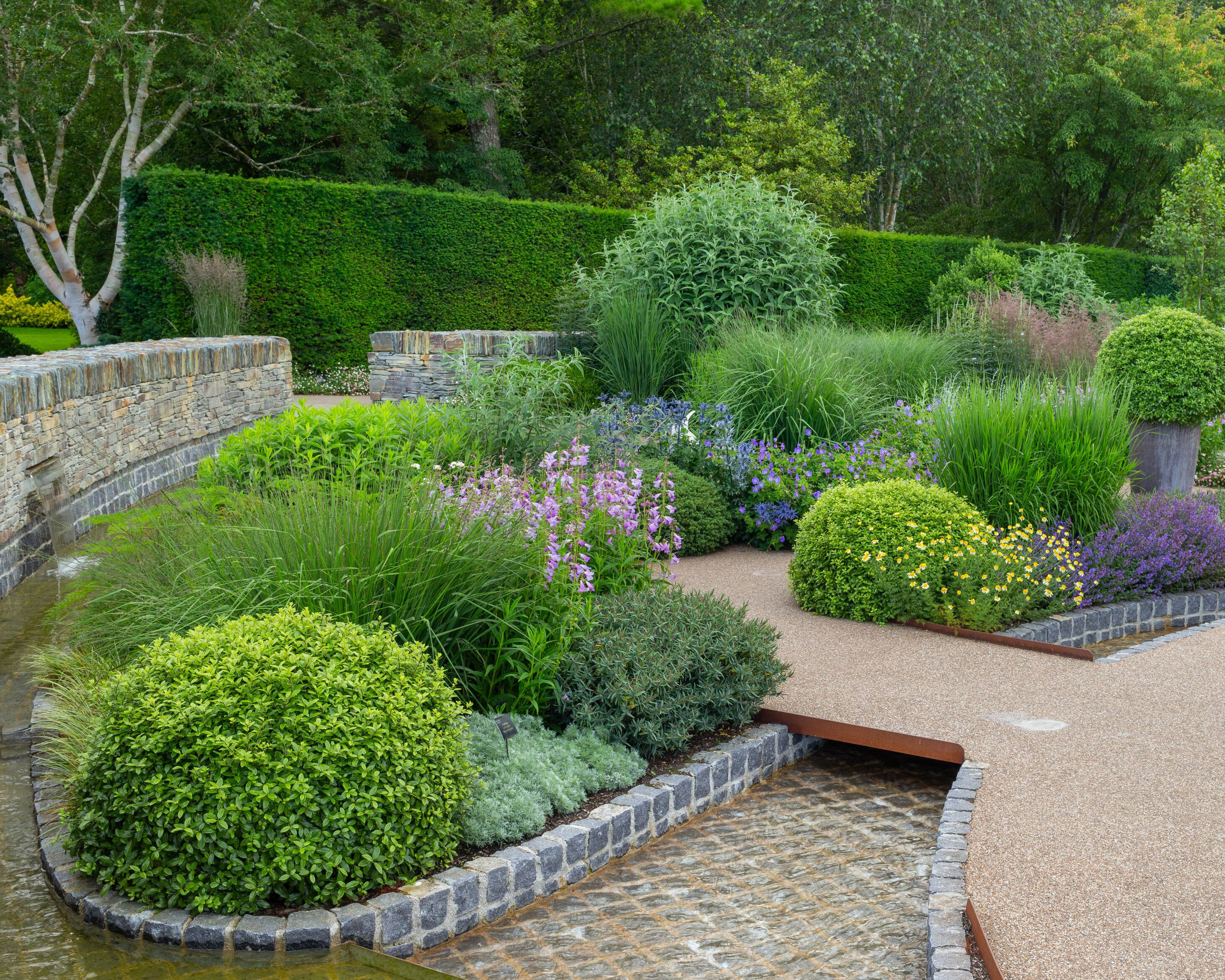
In areas that experience high rainfall, a cleverly designed rain garden can prevent your outdoor space from getting flooded
With the change in climate resulting in more regular and heavy downpours, get creative with ways to manage the rainwater and use it to your advantage. A sustainable garden idea is to connect downpipes with chains or channels to shallow dips that are planted with plants that can withstand getting waterlogged.
Garden designer Jo Thompson created The Cool Garden at RHS Rosemoor as a stunning example of what can be done to deal with heavy rainfall and flash flooding.
As a sloping garden idea, the ornamental water feature is overlooked by a curved terrace with five water blades that feed rills running down through the area into a teardrop-shaped pond. Planting is in shades of cool tones and the garden paths are made of permeable resin-bound gravel to help reduce surface water runoff.
'This garden has really high rainfall, so I decided to embrace that fact and make the collection of the water, its recirculation, and the play of light on the moving water the key feature of the garden,' explains Jo. 'The water is collected both in the channels and rills as well as draining through the porous surface used for the paths, and then is re-circulated through the garden.'
3. Build a natural swimming pool
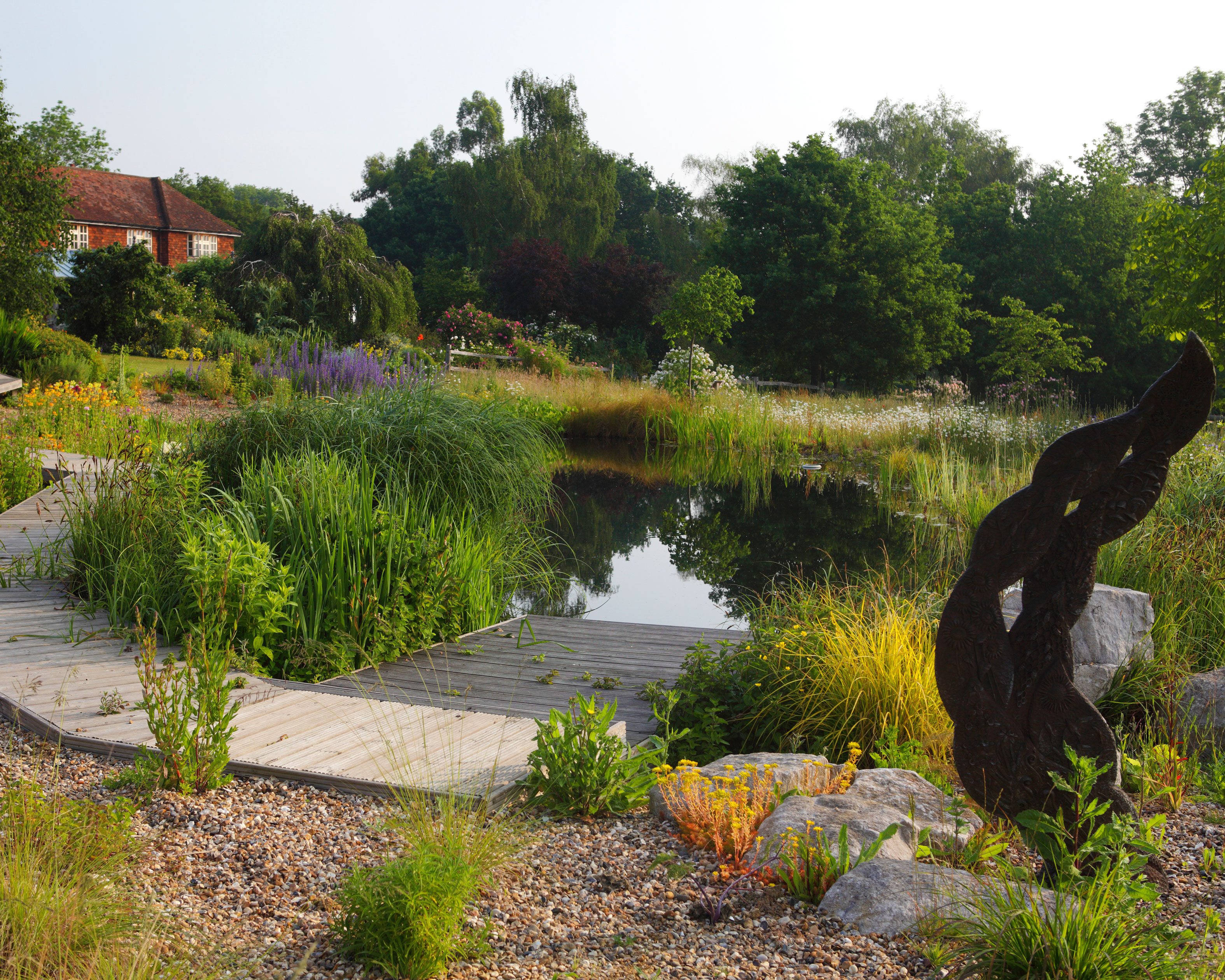
If you love the idea of swimming in a chemical-free environment, a natural swimming pool is the answer
Designed to blend in harmoniously with the landscape, a natural swimming pool resembles a pond but is carefully designed to be both a delight to swim in while also offering the opportunity to enjoy watching the likes of damselflies skimming the surface.
Unlike other pool ideas, 'a natural swimming pool is an organized pond, clear of chemicals. Whichever way it is configured – whether formal or organic in shape – there will be a large clear area for swimming and wide, shallow, planted margins. The result is a beautiful water garden idea rather than a plain blue rectangle, which will be alive all year and not just in the summer months,' explains Martin Kelley, managing director of Fairwater water garden specialists.
'The water in a natural swimming pool is naturally clean, with no chlorine taste or smell. This purity allows the natural world to share the water, with the shallow margins full of wonderful life,' he adds.
Maintaining clean water for swimming involves keeping the water clear of animals, ducks, and fish, along with fallen leaves and debris, to reduce the nutrients in the water and prevent algae. Some companies pump water through shingles as a filter, while others use plants to do the work.
'Without a chemical poison in the water, the biggest concern is the growth of algae. These are simple plants that grow from airborne spores, and microscopic seeds that colonize in nutrient-rich, warm water. Tap water is high in the algae’s favorite food, namely phosphates, and keeping these under control with biological treatments is essential,' says Martin.
The desirable marginal and pond plants will use some of these nutrients to grow but once the season is over, they and the leaves must be removed where possible, to prevent them from decaying in the water and releasing algae food for next year.
'The main body of the pond – the swimming zone – is left unplanted and should be cleared of stray floating plants or species that root to the pond floor. The regeneration zone is the planted, shingle margin and will benefit from any plant happy to grow in these hydroponic conditions. The depth of water can be adjusted by grading the shingle to allow for a full range of aquatic and marginal species. Deeper pockets will allow water lilies to thrive, whereas the shallows will be a great home for species such as iris, pickerel weed, flowering rush, or other grasses and sedges,' says Martin.
4. Include a wildlife pond
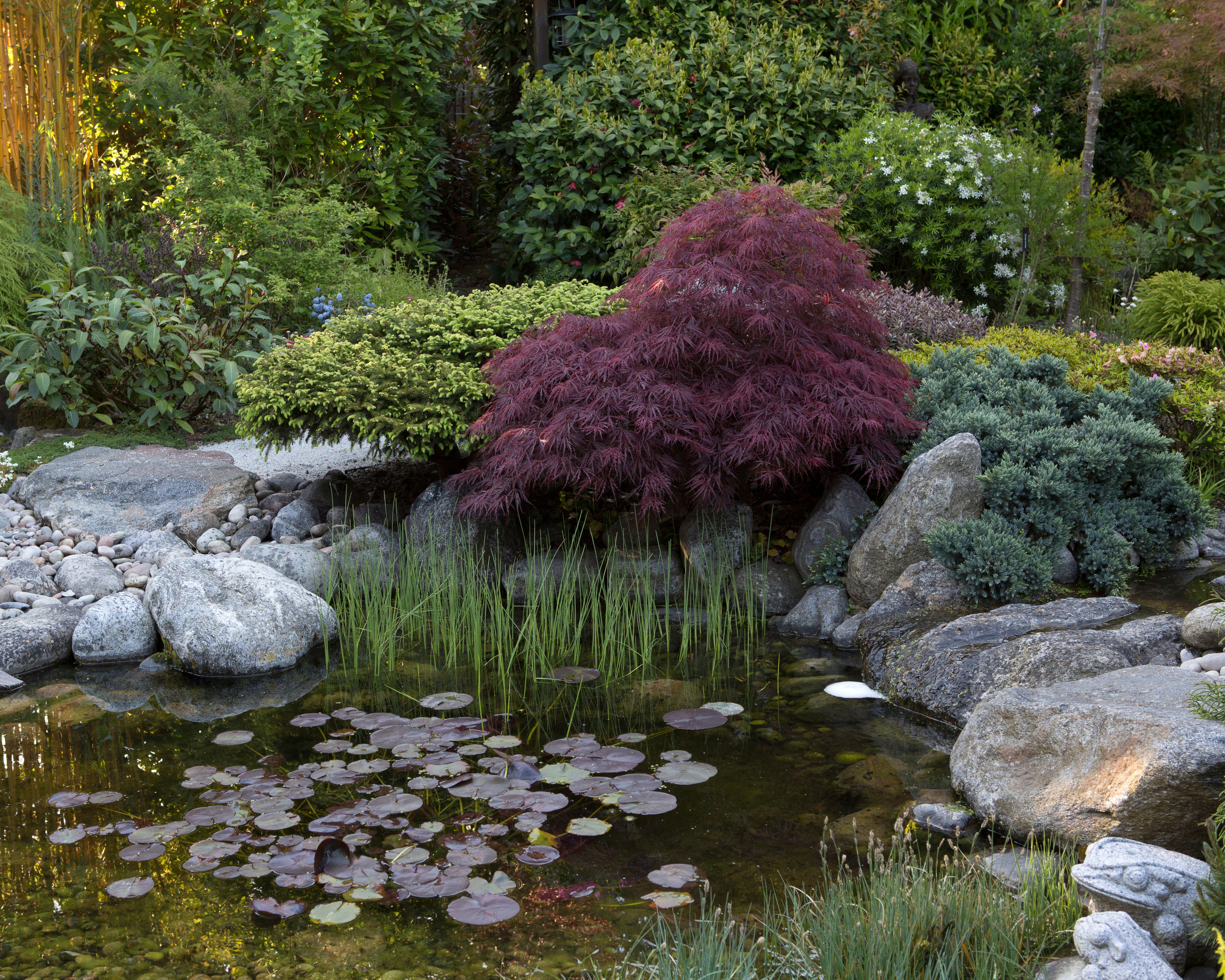
Sloping banks allow wildlife to easily access the pond
The aim of a wildlife pond is to emulate natural water pools with an organic, informal shape, where there will be both areas of shade and sun.
Almost as soon as you have constructed one you’ll see dragonflies appearing from nowhere to skim across the surface, beginning the parade of creature as they discover this new habitat among your wildlife garden.
To help attract a wide range of wildlife, plant at the water’s edge and sparingly in the water, and create contoured accessible banks and sloping ‘beaches,’ with areas for cover as well as open spots.
Blur the edges by layering water garden plants, as in nature, with aquatic oxygenators giving way to marginal planting, and then as it gets progressively drier moving away from the water, appropriate planting to suit the conditions. Plant as many native plant species as possible around a water garden. Place some stones and logs around the edges of the pond and a plank of wood or ramp will help any wildlife that may fall in.
Take care that surrounding trees won’t cast too much shade, or drop too many leaves – rotting leaves give off gases that can harm fish.
Varying depths in your pond will attract a wider variety of wildlife and help maintain a more complete environment. Your pond can be made from puddled clay or a good quality butyl liner and if possible fill it with rainwater.
5. Connect different zones with a shallow rill

When well designed, a narrow rill can create a contemporary look
Often running between fountains and ponds, rills are shallow channels along which water flows gently from one area to another, and work in gardens of all sizes. They can create a strong sense of perspective, dividing the outdoor space as part of your garden zoning and leading the eye to a focal point.
'Rills pre-date pipes as a means of transferring water and are generally narrow to prevent water loss through evaporation,' explains Martin Kelley of Fairwater.
'If your garden is on a gradient, a stepped rill can provide sound and movement as water drops from pool to pool, or a shallow, textured floor will produce white and excited water. If the site is flat, a level ribbon of water can be reflective and dramatic. Any rill will need to be securely constructed from masonry and well-lined as these thin structures can easily crack,' adds Martin.
For clear, sparkling water, chemically treat it to prevent algae; left untreated, simple plants, and even ferns, will find a foothold and add a different dimension.
These water gardens need to be perfectly engineered with the most appropriate pump, so it pays to engage the services of professionals. Materials for constructing rills can include stone, decorative tiles, toughened glass, or metals, such as aluminum, stainless steel, or corten steel.
6. Go for a more formal pond design
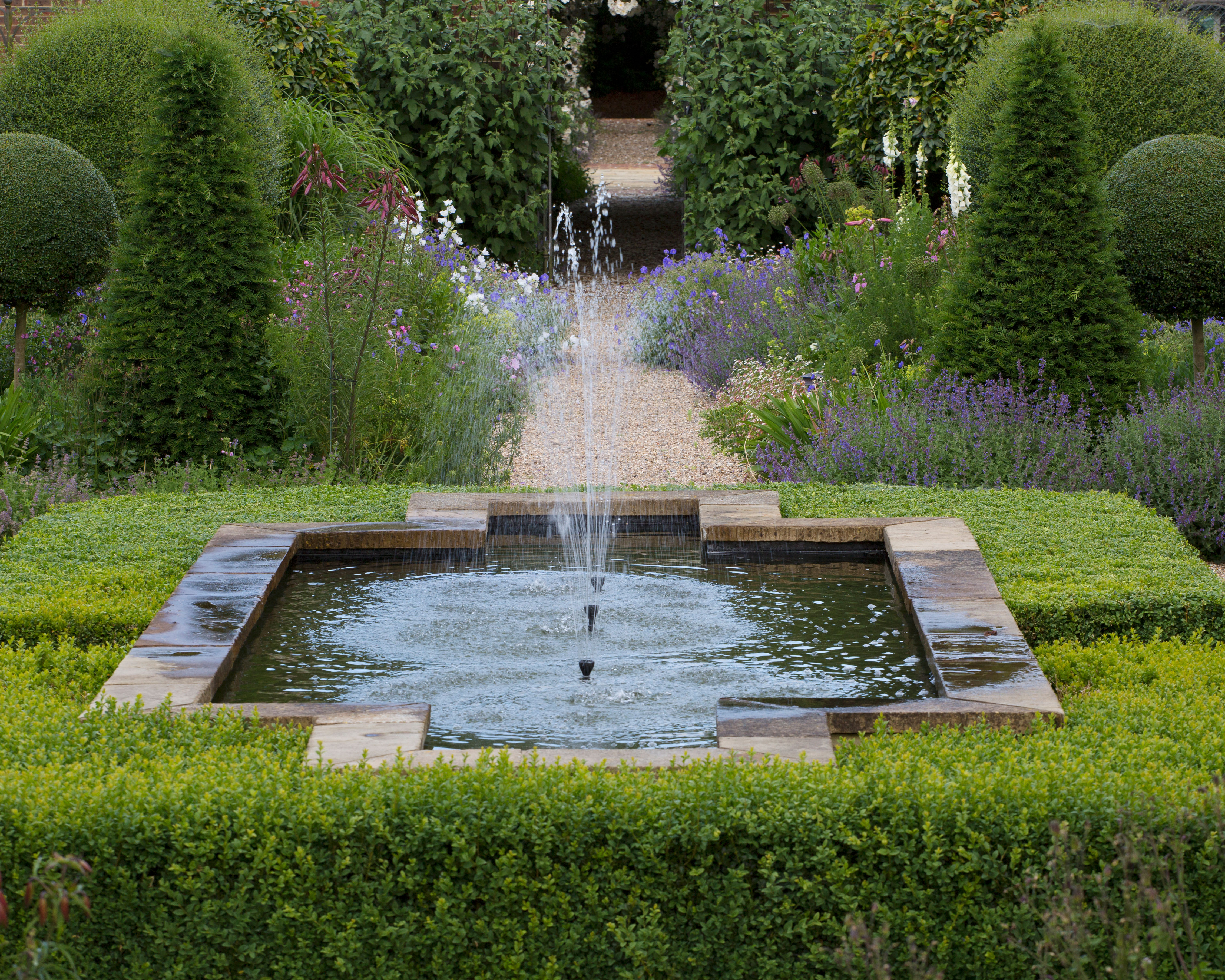
Keep planting simple around the edge of a formal pond
Ponds of still water have wonderful reflective qualities, to mirror trees, the sky, or buildings, depending on where you position them. The slightest breeze will also add sparkle and movement to the surface.
Formal ponds are designed as crisp geometric shapes – whether circles, ovals, squares or rectangles – and look appropriate set in lawns or in paving as a patio idea. They can be at ground level or built up above with capped edges, which could double as seating. The scale of a formal garden pond is important to keep all areas in the garden in proportion.
A dark lining will increase the reflective qualities of a formal garden pond and you can include aquatic plants in pots or baskets or leave the water clear. The depth will need to be at least 23 inches if you wish to include fish, and if it is very shallow the pond may dry out in hot weather.
Planting around these formal ponds is usually restrained to let the lines of the pond take precedence.
7. Create a focal point with a fountain
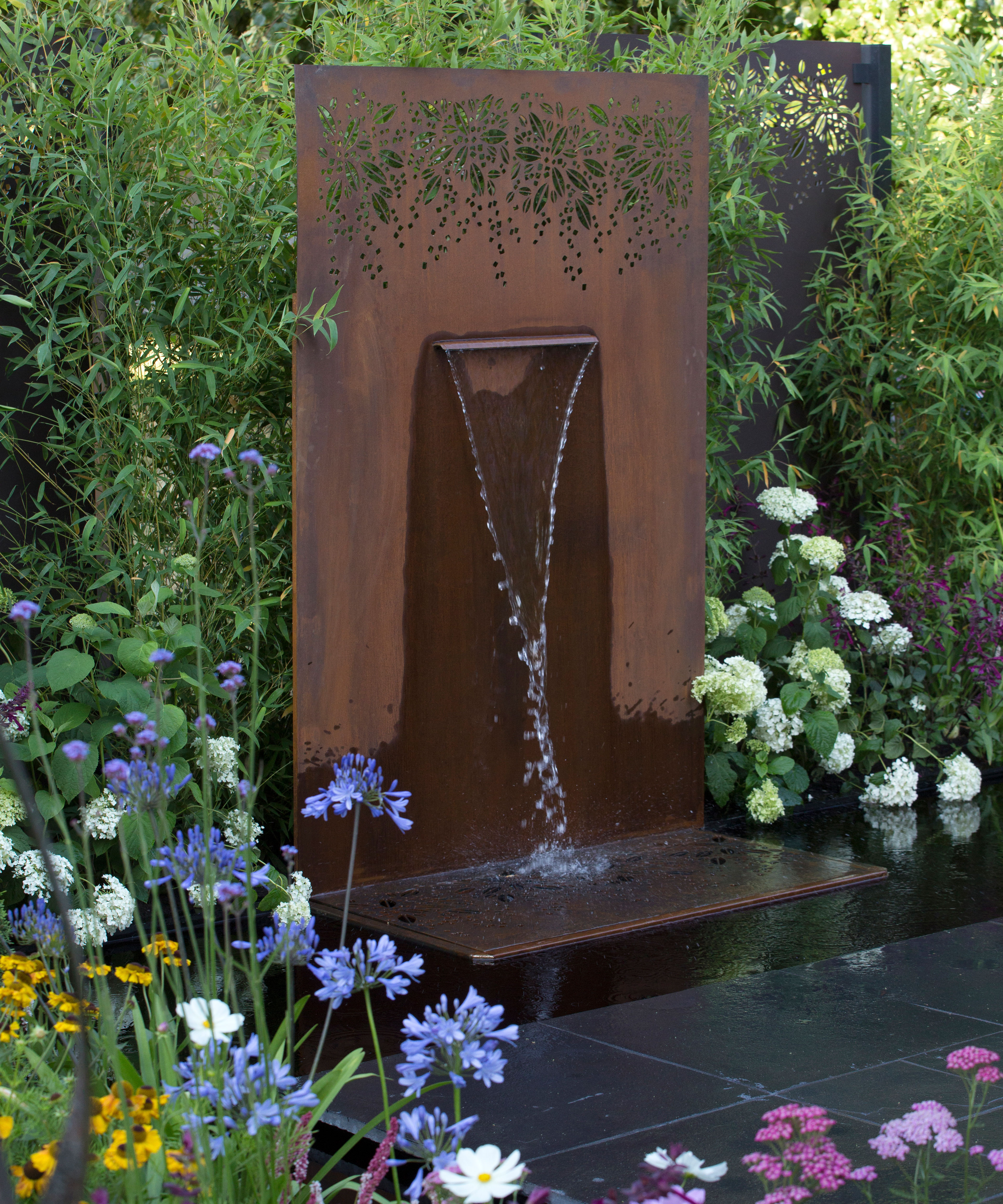
Corten steel is a striking choice for a water fountain material
Water features have graced gardens for centuries, with garden fountain ideas being among the earliest. Early wall fountains were driven by gravity, but by the 18th century, pumps were used to feed the water through.
Some wall-mounted fountains are self-contained, spouting the jet of water into a small tank, where a pump then circulates the water. Others send the water to a tank at ground level or onto stones that conceal the hidden tank with a submersible pump.
Electric or solar-powered wall fountains are available to buy that include the sculpture and all the parts. Seek the advice of a qualified electrician if you are unsure about electrical installation.
Empty and clean your wall fountain every couple of months to avoid algae building up and ensure there is enough water in the fountain to keep it working effectively. If the pump stops working, first check to see if it is clogged with debris, check the water level, and that the fountain isn’t leaking.
8. Keep it simple with a repurposed water container
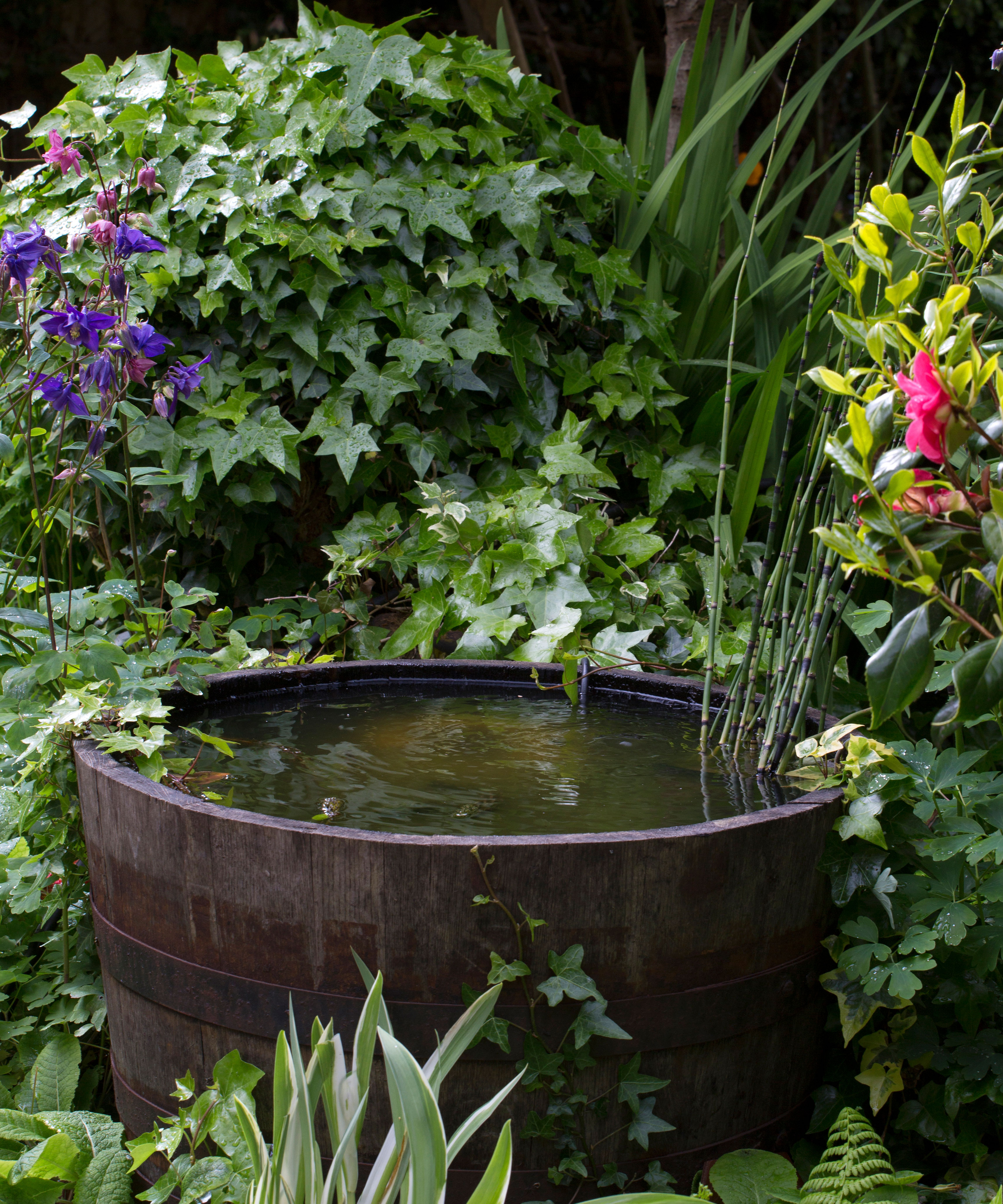
Old containers can be given a new lease of life as a water garden
Finding interesting containers to use as a water garden idea – from half barrels to animal drinking troughs – is a fabulous way to introduce the soothing sound of water to your plot.
You will need to line wooden containers with a double layer of pond liner fabric (available from Amazon) that is at least 10mm thick to avoid water leaching out, and with any container, ensure it hasn’t been treated with any poisonous chemicals that can leach into the water and kill fish or plants.
Be sparing with your planting for a simple look – consider the likes of irises, sedges, or waterlilies. Aquatic or marginal plants are generally fast-growing, so you will achieve a fairly instant effect.
These small-scale water garden ideas make excellent focal points in a courtyard garden, whether positioned on the ground or elevated for more prominence, while they can create a lovely vignette surrounded by planting in beds or borders.
9. Attract feathered friends with a bird bath
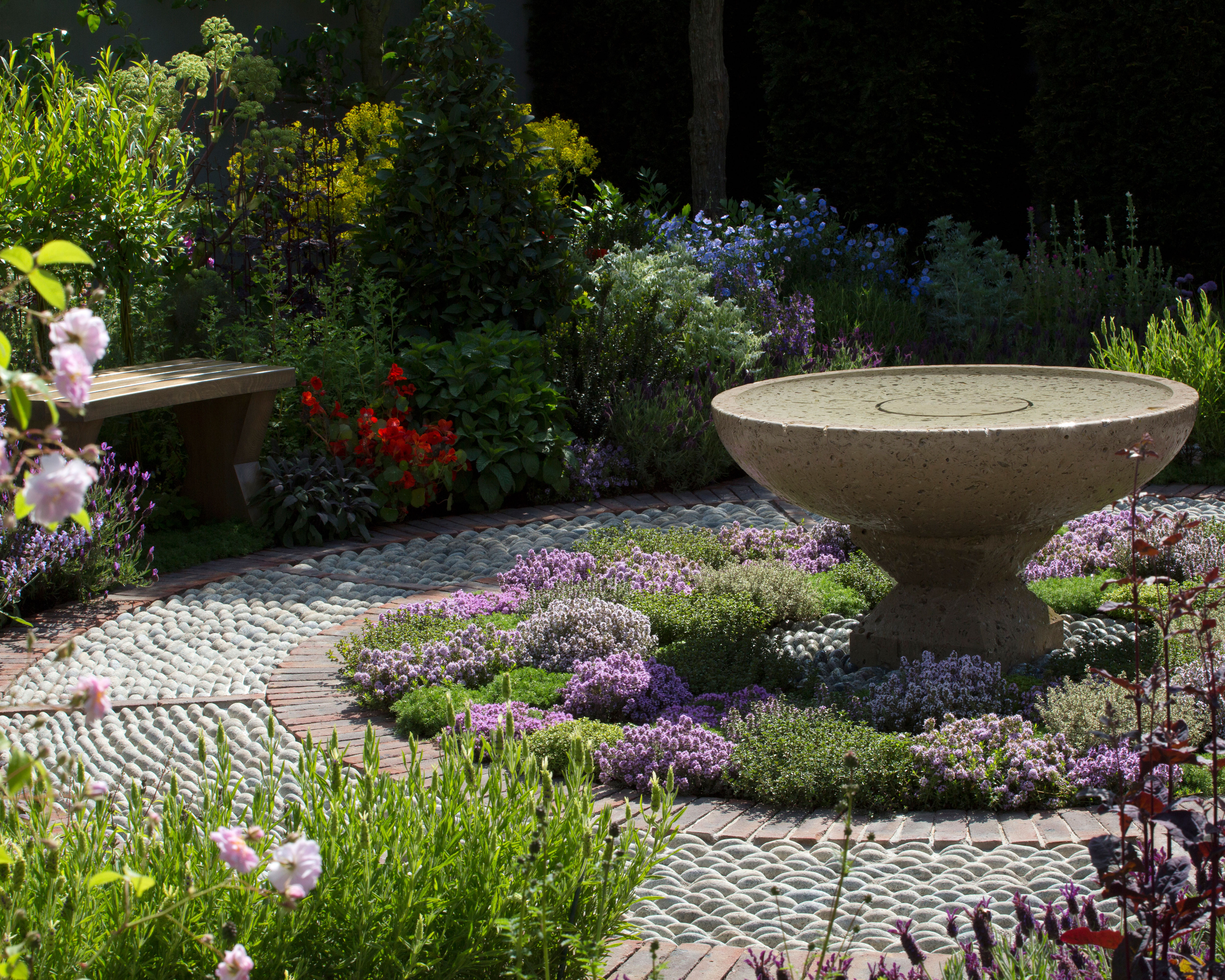
A statement bird bath can become a key focal point in your space
Even introducing a simple bird bath idea will encourage wildlife into your garden, providing a reliable, clean source of water for birds to drink from and also to bathe in to clean and preen their feathers. Bird baths can be especially important when natural sources are either frozen in winter or dried up in summer.
Choose a sturdy design that is easy to keep clean, and has rough sides for birds to perch on, or add some pebbles in the water. Ideally, a bird bath should be rinsed out daily and cleaned every week to avoid the build-up of bird droppings, algae, and dead leaves. Wear gloves and use a non-toxic household disinfectant followed by a thorough rinse.
The RSPB recommends a sloping bird bath, with water between a depth of 1-4 inches. Position it in an open spot where birds will feel safe and are able to fly off to nearby cover.
Stone is a traditional choice and works well among cottage garden plants or even as a focal point if you are designing a parterre garden. But there are lots of decorative options and shapes to choose from, whether to position in garden beds, on the lawn, or among the flowering medley of a wildflower garden.
How do you make a simple water garden?
There are many ways that you can create a simple water garden. A large plant pot, bucket, or any watertight container can become a mini oasis, which could attract damsel and dragonflies, frogs, birds, bats, and other wildlife.
Avoid porous containers and also plastic if you intend to have fish, as chemicals can leach out into the water. Choose a spot in partial shade, and include some rocks or gravel at the bottom so creatures can climb in and out or perch. Put one or two plants, such as miniature waterlilies or rushes, in aquatic baskets into the container and fill it with rainwater. Adding a small pump or bubbler reduces algae and mosquitoes while infusing the water with oxygen.
The soothing sound of water is a pleasing addition to any backyard, so any way you can introduce it to your space is beneficial. What's more, they're an incredibly effective way to give your yard a decorative focal point, even turning a forgotten, unloved corner into a welcoming spot.

Leigh Clapp is a professional photographer with over 25 years experience, primarily as a garden specialist photojournalist but also with food and travel. She delights in exploring gardens, discovering the tiny elements to their overall essence and meeting lots of enthusiastic gardeners along the way. Leigh’s work appears in magazines, newspapers and books, both in the UK and abroad, including Period Living, Country Life, and Gardens Illustrated; as well as being sole photographer for a number of books, including Garden Details, Feng Shui in the Garden, Vertical Gardens and From the Garden – fresh seasonal cooking.